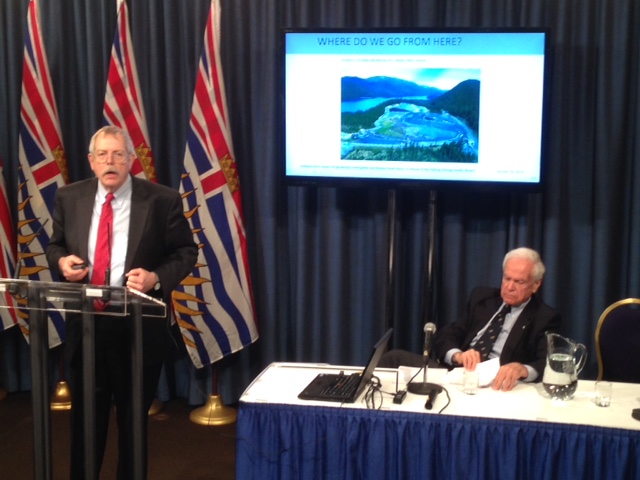WATCH: We now know what caused the disastrous collapse of the tailings pond at the Mount Polley mine. John Daly explains how these critical factors came together, resulting in the worst mine disaster in BC history.

Failure in the foundation embankment is what led to the tailings pond breach at Mount Polley site that sent millions of cubic meters of waste into Hazeltine Creek, Quesnel Lake and Polley Lake last year. That’s the conclusion of a report released by the B.C. government this morning.
An independent panel of engineers was formed to find out why the tailings pond burst last August.
The panel concluded that the dominant contribution to the failure resides in the design, particularly the glacial lake deposit in the foundation embankment that was not taken into consideration.
“The design did not take into account the complexity of the sub-glacial and pre-glacial geological environment associated with the perimeter embankment foundation,” said panel chair Norbert Morgenstern. “As the result, foundation investigations and associated site characterization failed to identify this continuous layer in the vicinity of the breach and to recognize it was susceptible to failure when subject to the stresses associated with the embankment.”
The panel looked into three other possible causes that could have led to the breach.
WATCH: More reaction to the Mount Polley report
It has found no evidence of human intervention or sabotage. The panel also concluded there was no evidence of failure due to inadequate water control or overtopping.
The inadequate control of migration through the core was considered and the panel says it could have been a concern, but ultimately the panel concluded the tailings pond did not breach because of that.
While today’s report addresses the possible causes of the tailings pond breach, any fines or prosecution will not be determined until the Conservation Office Service and Chief Inspector of Mines investigations are complete.
PHOTO: The independent panel releases its findings

Minister of Energy and Mines Bill Bennett says the panel concluded no surface inspections could have detected the problem and there were no warning signs.
“No one could have known this would happen unless they knew about the strength and the location of those sub-surface materials in that layer and apparently nobody did,” says Bennett.
He says the failure identified is much more complex than was originally thought, and the compliance was based on a design that failed to account for a layer of unstable material.
Bennett says having a defined cause will enable the industry and government to respond more comprehensively.
- Three B.C. men fined, banned from hunting after killing pregnant deer
- B.C. child-killer’s attempt to keep new identity secret draws widespread outrage
- Inquest hears B.C. hostage was lying on her captor before fatal shooting
- ‘We’ve had to make a 180’: What Oregonians say they got wrong with decriminalization
“I am relieved that we have a cause,” says Bennett. “One of the things I was concerned about in the beginning was that we would end up with multiple causes and that we would be left to sort out what causes might have caused this accident.”
Opposition New Democrat Leader John Horgan said the report highlight’s B.C.’s need for stricter mine inspection and review policies. He said the current inspection system, which has endured government cuts, didn’t identify problems at Mount Polley.
“It’s a failure, I believe, of our regulatory process. It’s a failure of the deregulation that the B.C. Liberals brought into play in 2001 when they were first elected.”
The panel has made seven recommendations and three actions in response to these recommendations were announced by Bennett today.
There are currently 98 permitted tailings storage facilities in the province with 123 dams at 60 metal and coal mines in B.C.
All operating mines with tailings storage facility dams will now have to provide a letter to the ministry by June 30, 2015 to confirm whether the foundation materials similar to those at Mount Polley exist below any of their dams.
There is also a new requirement that all operating mines with tailings storage facilities establish independent tailings pond review boards.
Finally, there will be a code review to determine how to best implement the panel’s remaining recommendations, including the adoption of best available practices and technologies.
It’s something that we need to do and will do, says Bennett. There should be zero failures of this nature. This obviously was an unprecedented disastrous event that we must do everything we can to ensure it does not happen again.
– With files from The Canadian Press



Comments